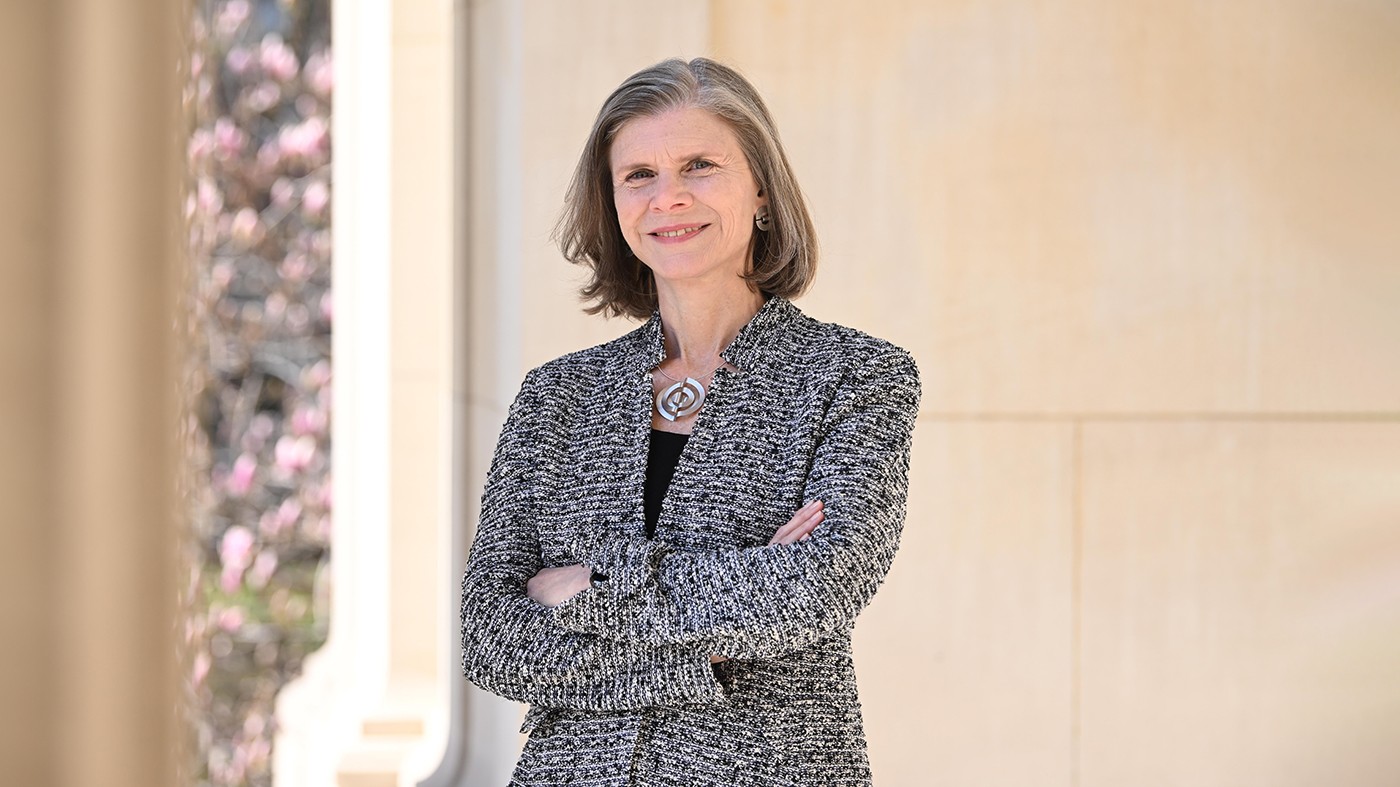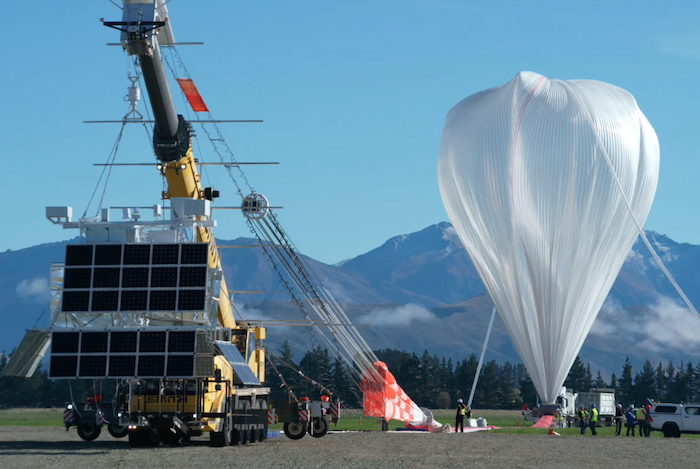Meet Angela Olinto, Columbia’s New Provost
Learn about her passion for astroparticle physics, why she donated her guitar, and what extreme sport she would like to do—again.

Angela Olinto, a pioneer in astroparticle physics, officially started as Columbia’s new provost today. The former dean of the Division of the Physical Sciences at the University of Chicago, Olinto has been on campus for about a month getting acquainted with her new colleagues. She has given a lecture to Columbia faculty and students on the balloon missions she has conducted with NASA and how they are helping us understand high energy phenomena in the universe. Olinto is also making plans to move her lab to Columbia and preparing to work with Columbia students and postdocs.
Last week, Columbia News managed to wrangle some time on her busy schedule and spoke with her in her new office in Low Library.
Your research has made seminal contributions to our understanding of the inflationary origins of the universe, the cosmological effects of magnetic fields, the structure of neutron stars, and the highest energy cosmic rays, gamma-rays, and neutrinos. Can you describe the moment when you realized, ‘I want to devote my life to the workings of the universe’?
I have always been driven by curiosity about how the world works, from the simplest physical systems to the whole universe. Physics became a passion. The idea that with a few laws of physics, you can explain almost everything we observe in nature is really impressive. It still amazes me. That excitement about connecting the world out there with the basic laws of physics motivated me to help establish the field of what we now call astroparticle physics—using the universe to understand fundamental physics.
You are bringing your lab with you from the University of Chicago. What goes on in your lab? How will Columbia students and postdocs get to participate?
I lead a medium-sized collaboration with about 60 people working all over the world. We design and build space missions with the goal of understanding how the highest energy particles in the universe behave. The types of particles we study are called cosmic rays and neutrinos. In my team, students, postdocs, and scientists can get involved in a suborbital space mission: building telescopes and flying them, developing cameras that can take hundreds of millions of pictures per second, making videos of what's happening in the atmosphere when these particles arrive, getting the data, analyzing the results, and going all over the world to discuss it with other colleagues. Our collaboration involves teams in Italy, France, Germany, Czech Republic, Poland, Japan, and other countries.
Tell us about your work with NASA.
In 1995 I engaged as a theorist to help design and build the largest observatory of astroparticle physics, the Pierre Auger Observatory. It is a 3,000 square kilometer array in Argentina with 1,660 detectors. My work with this giant observatory, which is still operating, led me to explore the development of new technologies to use NASA platforms, super-pressure balloons in particular, to study these astroparticles. In 2014, we launched the first balloon and another one in 2017. We also deployed a detector to the International Space Station in 2019. Our last balloon ride in 2023 was cut short because the balloon did not perform according to plan, but we did get enough data to show that our technologies can make important contributions. The next balloon mission should be able to answer many crucial questions related to the origin of these astroparticles.

You were the first woman to receive tenure in the Department of Astronomy and Astrophysics, the first woman chair of any department in the Physical Sciences Division, and the first woman dean of the Physical Sciences Division at the University of Chicago, which means overseeing the departments of Astronomy and Astrophysics, Chemistry, Computer Science, Geophysical Sciences, Mathematics, Physics, and Statistics, as well as a number of research institutes and centers. What have you learned from these pathbreaking experiences that inform your approach to academic leadership?
Trailblazing is hard work. It takes passion for what we do and belief that the future will be better than the past. There is a lot of learning involved. In my case, I learned to be more flexible, to choose the fights that I have to fight and ignore those I don't have time for. I am really excited to see the next generations do better than mine. When I entered MIT, I was one of two women out of about 60 graduate students, or 3 percent. By the time I was dean of the Physical Sciences Division at Chicago, over 40 percent of students entering graduate studies in physics were women. To see that growth over my lifetime has been a wonderful ride.
What are some of the most exciting questions and biggest challenges that you see facing the sciences now?
In my own field, the question of how the universe began is a big one. What is dark matter? What are the reasons for the accelerating universe? Is there life on other planets? The origin of the universe, the origin of life, and the origin of consciousness are three fundamental origins that science can help us unveil.
Climate change is a major challenge that science can help alleviate. Artificial intelligence will revolutionize everything that we know. There is also the quantum revolution, which will transform computing, sensing, and communications. The power of nanoscale engineering to change biology. Being able to manipulate DNA, RNA, cells—and their consequences for health and better lives—is another major effort. There are so many exciting things happening now in science.
Underneath what we do—from science to humanities—curiosity unites us all.
You taught a course at Chicago nicknamed cosmology for poets. What do poets need to know about cosmology?
Underneath what we do—from science to humanities—curiosity unites us all. The connection between poets and science has gone back thousands of years. In my course, I use Edgar Allan Poe’s “Eureka,” where he explores core questions of cosmology: Is the universe finite or infinite? Is it evolving? Artists have been inspired by views of the universe. Helen Frankenthaler’s “Focus on Mars” or Kiki Smith’s series on the moon are compelling examples. And in the other direction, imagination in the arts has inspired scientists in advancing their understanding of the cosmos. So it seems appropriate to engage the arts into the discussion of what we have learned about the universe and its mysteries, like dark matter and dark energy.
What attracted you to Columbia University and the job of Provost?
What attracted me to Columbia was President Shafik and her vision of Columbia’s leadership in academic excellence in research and teaching, in global and local engagement, and in tackling the hardest problems of today and the future, including climate change, artificial intelligence, and mental health. I inherited my father’s passion and admiration for The Great American University. I’m eager to contribute my small part to developing and preserving the greatness of American universities, and to growing this extraordinary institution.
What are you looking forward to about living in New York City?
New York City is the economic, cultural, and intellectual capital of the planet, and it has more to offer than I possibly have time to enjoy. I look forward to spending time with family and friends who live in the city and engaging with the Columbia community and its connections to the city in all of the fields of intellectual discovery and exploration. I'm excited to explore the city through the eyes of the University.
Tell us about your childhood.
I was born in Boston when my father was studying for his PhD at MIT. Then my mother, who was pregnant with my sister, decided to go back to Brazil, to have the support of her family. I was 2 years old, so I grew up in Rio de Janeiro, and enjoyed the beaches and riding horses in the mountains near Rio. Riding the waves was part of my childhood in Rio and I love to go back and breathe the maresia—the sea air. When I was in fifth grade my siblings and I moved with my mother to Brasilia, where I went to middle and high school during the military dictatorship. I came back to Rio to do my undergraduate studies at the Pontifical Universidade Catolica, or PUC, where I entered the university at 16 and learned a lot about physics. I also learned how to engage and lead students to protest the dictatorship and fight for democracy.
There will be a total solar eclipse on Monday, April 8, that will cross North America, passing over Mexico, the United States, and Canada. How do you plan to experience it?
I’m driving with friends to Vermont, to experience the totality of the eclipse, when the sun will be blocked almost completely by the moon. When that happens, you can see amazing things, the change in the weather—it gets cooler fast—the light changes and even animals change behavior. It's quite an exciting event. The pearl necklace or the diamond ring around the moon, that little bit of the sun, makes for beautiful images if the weather permits. The sun’s corona is also an amazing sight. It's worth the many hours’ drive and likely the big traffic jam on the way back home. A total eclipse is worth the effort. Even the partial eclipse here in New York City will be worth a break in people’s daily lives—but please wear certified eclipse glasses!
Your husband, Sérgio Assad, is half of what critics consider the world’s leading classical guitar duo, with his brother Odair. Do you play an instrument? What do you like to do in your free time?
I used to play guitar until I met Sérgio. I very quickly donated my guitar and decided that listening to him play, especially his compositions, is a much better investment of my time. My husband and his whole family are incredible musicians. My stepdaughter, Clarice, is just unbelievable. She's exploring new kinds of orchestral work, new ways of communicating music in the classical and Brazilian styles.
My own ongoing passion is to learn about visual arts. Some of my favorite artists are nearby in Chelsea galleries that I can now visit on weekends.
Tell us something that few people know about you.
I enjoy testing boundaries. Not just in science, but also in other ways. I explored the limits of my own body during a phase in which I was rock climbing, paragliding, bungee jumping, and parachuting. At my body’s request, I don’t do these extreme sports anymore, but I really enjoyed them. I would love to bungee jump again.